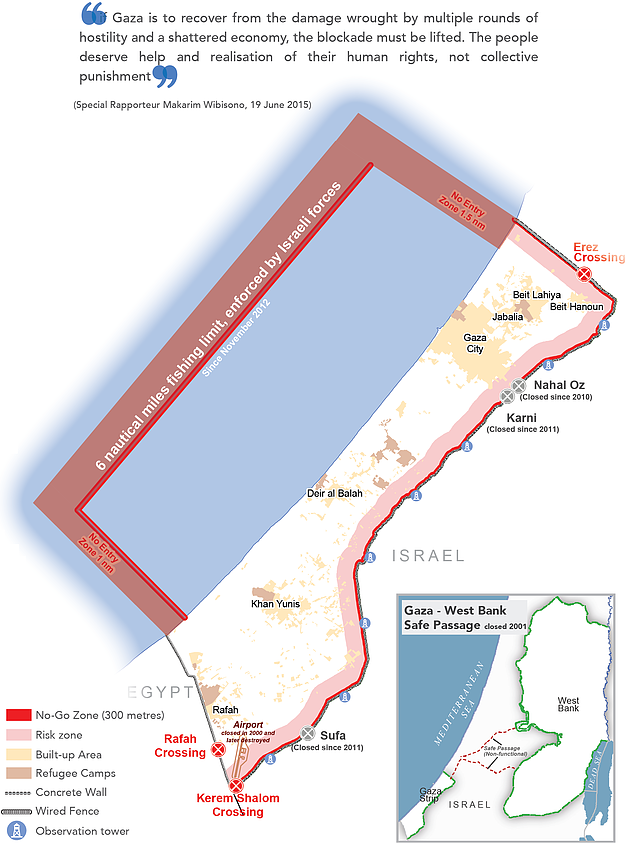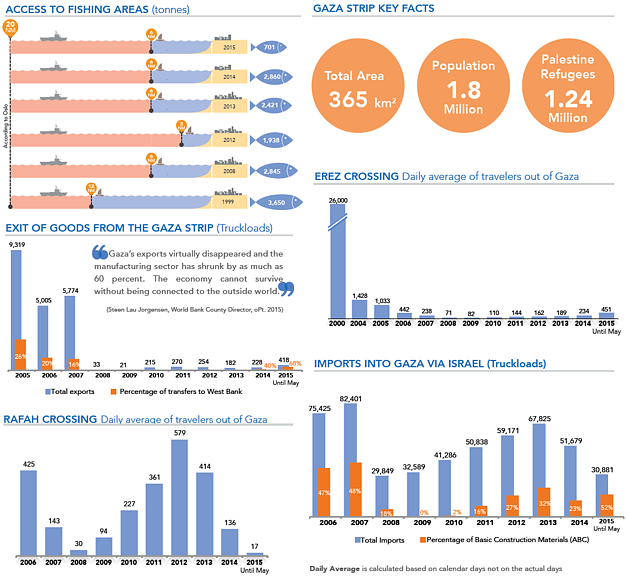The Gaza Strip: The Humanitarian Impact of the Blockade | July 2015
Key Facts
- In June 2007, following the takeover of Gaza by Hamas, Israel imposed a land, sea and air blockade on the Gaza Strip.
- The blockade has reduced Gaza’s GDP by 50% (The World Bank, May 2015).
- The unemployment rate in Gaza during 2014 stood at 43% on average: the highest in the world. Youth unemployment exceeded 60% (PCBS).
- Nearly 80% of Gaza’s population receives some form of international aid, the bulk of which is food assistance.
- The daily average of crossings by permit holders out of Gaza via the Israeli-controlled Erez Crossing in the first five months of 2015 stood at 449, more than double the same period of 2014, but less than 2% of the 26,000 daily crossings prior to September 2000 (second intifada).
- The Egyptian-controlled crossing (Rafah) has been continuously closed, including for humanitarian assistance, since 24 October 2014, except for 15 out of 219 days of partial openings, as of May 2015.
- Kerem Shalom is the only commercial crossing currently operating, out of four such crossings prior to the imposition of the blockade.
- Israel defines basic construction materials (gravel, steel bars, and cement), along with a wide range of spare parts, computer equipment, and vehicles, as “dual use” items, restricting their import.
- Less than 1% of the construction materials required to rebuild houses destroyed and damaged during hostilities, and to address natural population growth, have so far entered Gaza (Shelter Cluster, June 2015).
- 408 truckloads of commercial goods exited Gaza via Israel in the first five months of 2015, an almost five-fold increase compared to the same period of 2014 (83), but only 7% of the volume in the equivalent period of 2007, prior to the imposition of the blockade (5,451 truckloads).
- Access to areas within several hundred metres from the Israeli fence surrounding Gaza is risky or prohibited, discouraging or preventing farming activities.
- Fishermen are allowed to access less than one third of the fishing areas allocated to them under the Oslo Accords: six out of 20 nautical miles.

- 1.8 million Palestinians in Gaza are ‘locked in’, denied free access to the remainder of the occupied Palestinian territory and the outside world. Movement restrictions imposed by Israel since the early 1990’s and intensified in June 2007, citing security concerns, have undermined the living conditions in Gaza and fragmented the OPT and its economic and social fabric. In recent months the Israeli authorities have significantly increased the number of exit permits issued to Palestinians, however, those eligible for such permits still constitute a small minority, primarily patients, business people and staff of international organizations. The isolation of Gaza has been exacerbated by restrictions imposed by the Egyptian authorities on its single passengers crossing (Rafah).
- Longstanding access restrictions imposed by Israel have undermined Gaza’s economy, resulting in high levels of unemployment, food insecurity and aid dependency. These include restrictions on transfer of goods to the West Bank and Israel; on the import of “dual use items”; and on the access of people to agricultural land and fishing waters. The Israeli authorities have recently eased some of these restrictions, but the basic constraints remain in place, preventing a significant improvement in the economy. This is compounded by the destruction of economic assets during hostilities, the severe electricity shortage and the inability of the Palestinian Government of National Consensus to assume effective government functions in Gaza, due to the ongoing internal divide.
- Israeli restrictions on the import of basic construction materials and equipment have significantly deteriorated the quality of basic services, and impede the reconstruction and repair of homes. The limited access to these materials since 2007 has prevented or delayed the construction, repair and upgrade of homes and infrastructure, to address the rapid population growth and the devastation caused by recurrent rounds of hostilities. This has undermined the quality of health, education, and water and sanitation services available in Gaza, and prolonged the displacement of those who have lost their homes. While the import restrictions remain in place, following the August 2014 ceasefire, a temporary Gaza Reconstruction Mechanism (GRM) allowing for the controlled entry of the restricted materials was established, triggering a significant increase in the entry of such materials.
- Israel, as the occupying power, must lift the blockade, which prevents the realization of a broad range of human rights for Palestinians in Gaza. The Secretary General of the United Nations has stated that the blockade and its related restrictions contravene article 33 of the Geneva Convention IV prohibiting collective penalties. While Israel’s recent relaxation measures are welcomed, a full lifting is paramount to stopping the continuing deterioration of the living conditions in Gaza and preventing a new cycle of violence.











